The Solar Salt Market is estimated to be valued at USD 5.4 billion in 2025 and is projected to reach USD 8.3 billion by 2035, registering a compound annual growth rate (CAGR) of 4.5% over the forecast period.
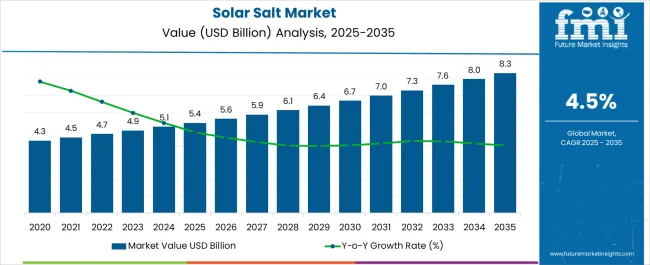
| Metric | Value |
|---|---|
| Solar Salt Market Estimated Value in (2025 E) | USD 5.4 billion |
| Solar Salt Market Forecast Value in (2035 F) | USD 8.3 billion |
| Forecast CAGR (2025 to 2035) | 4.5% |
The solar salt market is experiencing steady growth as industries increasingly emphasize sustainable and cost effective salt production methods. Rising demand from chemical, food processing, and water treatment industries is fueling the adoption of solar salt due to its high purity and eco friendly extraction process.
Technological improvements in large scale evaporation ponds and controlled crystallization methods are enhancing both yield and quality, making solar salt a preferred raw material across multiple sectors. Environmental advantages, such as reduced carbon footprint compared to mined alternatives, are also supporting adoption.
Regulatory push for sustainable raw material sourcing and rising industrialization in emerging economies are further creating favorable market dynamics. The outlook remains positive as end use industries continue to expand production capacities and align supply chains with renewable and resource efficient inputs.
The market is segmented by Source, Form, Application, and End-use and region. By Source, the market is divided into Underground Brine and Sea Water. In terms of Form, the market is classified into Pellet, Fine, and Granular. Based on Application, the market is segmented into Chemical Processing, De-Icing, Water Treatment, Oil & Gas, Agriculture, Flavoring Agent, and Others. By End-use, the market is divided into Commercial and Household. Regionally, the market is classified into North America, Latin America, Western Europe, Eastern Europe, Balkan & Baltic Countries, Russia & Belarus, Central Asia, East Asia, South Asia & Pacific, and the Middle East & Africa.
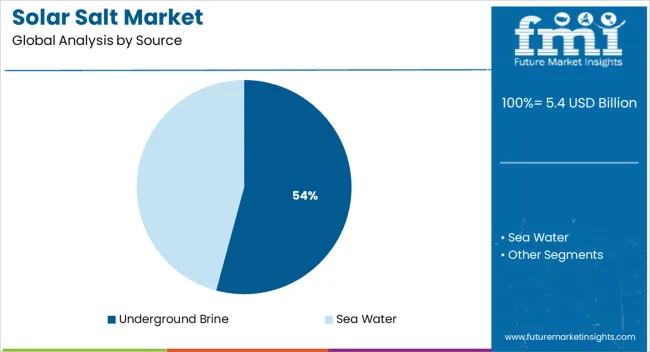
The underground brine segment is expected to account for 54.20% of the total market revenue by 2025 within the source category, making it the leading segment. Its dominance is supported by abundant availability, consistent quality, and suitability for large scale solar evaporation.
This source is cost effective compared to traditional mining and ensures a steady supply for industrial users.
The efficiency of extraction and the scalability of underground brine operations have positioned it as the most reliable option for producers aiming to meet rising global demand.
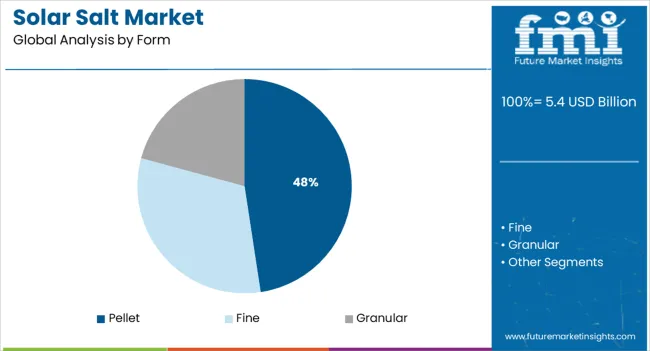
The pellet form is projected to contribute 47.60% of the overall revenue share by 2025, establishing itself as the dominant form category. Pellets are widely valued for their uniformity, ease of handling, and controlled dissolution rates, which are particularly advantageous in water conditioning and industrial applications.
Their ability to reduce maintenance issues in equipment and improve process efficiency has increased their adoption.
These functional benefits combined with consistent performance have reinforced pellets as the preferred form of solar salt in diverse applications.

The chemical processing segment is anticipated to hold 42.80% of total market revenue by 2025 under the application category, making it the leading segment. Growth is being driven by the extensive use of solar salt in chlor alkali production and other industrial chemical processes that require high purity input.
Consistent demand from large scale chemical manufacturing units, combined with the strategic importance of solar salt in critical industrial reactions, has elevated its role.
The reliance of global chemical industries on solar salt for efficient and sustainable processing continues to secure this segment’s leading market position.
With a CAGR of 5.0% between 2020 and 2025, the global market for Solar Salt Market expanded from USD 3,848.6 Million to USD 4,678.0 Million.
Global demand for chemicals and food products is anticipated to fuel the market for solar salt. Additionally, because to the rising population in the developing region, households are consuming huge amounts of solar salt to maintain a consistent demand. Global demand for solar salt is anticipated to rise as water treatment equipment becomes more prevalent in new areas and as home water softeners become more common.
Due to the high purity vacuum salt's expanding industrial use, the market for solar salt is anticipated to see restraint.
With a high CAGR of 4.5% over the projected period, it is expected that the global Solar Salt Market would increase from USD 4,911.9 Million in 2025 to USD 7,628.0 Million by 2035.

The Solar Salt market has been rapidly growing over the past few years, especially in North America. As solar energy becomes more cost-effective and reliable, many businesses are turning to solar salt as an alternative to traditional salts from chemical suppliers. This is driving a surge in the demand for solar salt in the region.
Solar salt provides a renewable source of energy that can be used for various industrial purposes such as water treatment, food processing, pharmaceutical production, and other industrial applications. Additionally, it offers environmental benefits by reducing hazardous emissions from conventional sources of power generation. Furthermore, it also helps to reduce overall energy costs and increase efficiency levels.
As a result of this increased demand for solar salt in North America, manufacturers are focusing on improving their production processes and developing new technologies that can meet customer requirements at competitive rates.
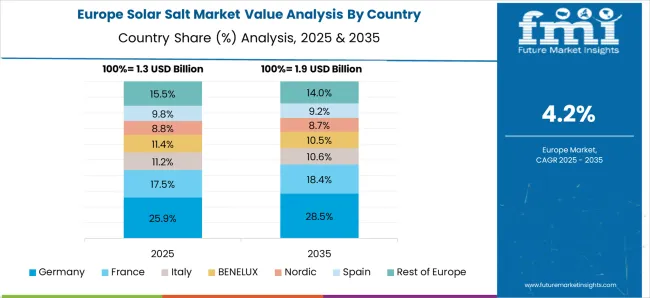
The market for solar salt in Europe is growing rapidly, as more and more countries are switching to renewable sources of energy. Solar salt has proven to be a reliable and cost effective way to store the sun’s energy, providing an important part of the overall move away from traditional sources of electricity production. Solar salt is also becoming increasingly popular with consumers, due to its low-cost nature when compared to other forms of renewable energy.
In recent months, the European market for solar salt has seen a marked increase in demand; this can be attributed in part to improved technology that makes capturing and storing solar energy more efficient. Furthermore, government policies aimed at promoting renewable energies have also played their part in encouraging investment into this sector.
The Solar Salt market in Asia Pacific is growing at a rapid rate. This is largely due to the increasing demand for renewable energy sources and improved environmental standards in the region. Furthermore, developing countries are also increasingly adopting solar salt as an alternative source of energy, as it offers a more cost-effective solution than traditional energy sources.
In recent years, several key players have made significant investments in the Solar Salt market in Asia Pacific. Companies such as China's Shenhuo Group and Japan's Itochu Corporation have invested heavily in research and development to make solar salt technology more efficient and affordable. These companies have also opened up their production facilities across different countries within the region, making it easier for customers to access solar salt products.
The oil and gas industry is a major user of solar salt, a type of evaporated sea salt. Solar salt is used in many applications related to the production, processing, storage and transportation of petroleum products.
Solar salt has properties that make it ideal for use in the oil and gas industry. It can be used as a corrosion inhibitor to prevent corrosion in tanks, pipes and other metal surfaces exposed to corrosive liquids or gases. In addition, solar salt can be used as an antifouling agent to reduce sludge build-up on vessel bottoms during long periods at sea or on extended idle times between voyages. Another application is its use as a brine solution for purification processes such as desalination or water softening systems within the industry.
Solar salt is an increasingly popular alternative to traditional chemical water treatments, due to its natural and safe properties. Solar salt is a type of natural mineral salt that has been used for centuries to clean and purify water. It works by reducing the bacteria count in water, which prevents the growth of disease-causing pathogens such as E. coli, salmonella, and cholera. Solar salt also removes heavy metals from water that can be harmful to human health.
When solar salt is added to contaminated water it begins working immediately to break down organic material like debris, algae, or other microorganisms which could otherwise contaminate drinking water supplies. This process helps eliminate unpleasant tastes and odors from the water as well as reduce harmful bacteria levels which can lead to diseases or other health issues for those who drink it.
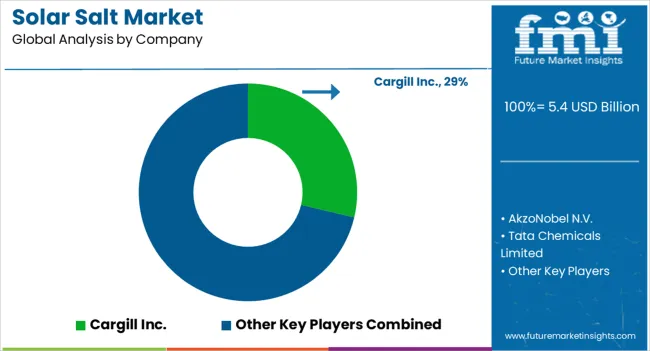
The solar salt market is a highly competitive industry, with a large number of players operating globally. Key players in the market include Cargill Inc., AkzoNobel N.V., Tata Chemicals Limited, K+S AG, and Compass Minerals. These companies have a strong presence in the market and offer a wide range of solar salt products.
Additionally, there are many smaller regional players that also play a significant role in the market. The competition in the market is intense, with companies competing on factors such as price, quality, and innovation.
| Attribute | Details |
|---|---|
| Forecast Period | 2025 to 2035 |
| Historical Data Available for | 2020 to 2025 |
| Market Analysis | USD Million for Value and Units for Volume |
| Key Regions Covered | North America; Latin America; Europe; Asia Pacific; MEA |
| Key Countries Covered | Philippines, India, Malaysia, Thailand, USA, Germany, China, Japan, Denmark, Canada, Mexico, Poland, UK, Turkey, France, Italy, Spain, South Korea, Russia, Australia, Brazil, Argentina, South Africa |
| Key Segments Covered | Source, Form, Application, End-use, Region |
| Key Companies Profiled | Cargill Inc.; AkzoNobel N.V.; Tata Chemicals Limited; K+S AG; Compass Minerals; Cheetham Salt Ltd.; Nirma Ltd.; Dampier Salt; Kensalt Ltd.; United Salt Corporation |
| Report Coverage | DROT Analysis, Market Forecast, Company Share Analysis, Market Dynamics and Challenges, Competitive Landscape and Strategic Growth Initiatives |
| Customization & Pricing | Available upon Request |
The global solar salt market is estimated to be valued at USD 5.4 billion in 2025.
The market size for the solar salt market is projected to reach USD 8.3 billion by 2035.
The solar salt market is expected to grow at a 4.5% CAGR between 2025 and 2035.
The key product types in solar salt market are underground brine and sea water.
In terms of form, pellet segment to command 47.6% share in the solar salt market in 2025.






Our Research Products

The "Full Research Suite" delivers actionable market intel, deep dives on markets or technologies, so clients act faster, cut risk, and unlock growth.

The Leaderboard benchmarks and ranks top vendors, classifying them as Established Leaders, Leading Challengers, or Disruptors & Challengers.

Locates where complements amplify value and substitutes erode it, forecasting net impact by horizon

We deliver granular, decision-grade intel: market sizing, 5-year forecasts, pricing, adoption, usage, revenue, and operational KPIs—plus competitor tracking, regulation, and value chains—across 60 countries broadly.

Spot the shifts before they hit your P&L. We track inflection points, adoption curves, pricing moves, and ecosystem plays to show where demand is heading, why it is changing, and what to do next across high-growth markets and disruptive tech

Real-time reads of user behavior. We track shifting priorities, perceptions of today’s and next-gen services, and provider experience, then pace how fast tech moves from trial to adoption, blending buyer, consumer, and channel inputs with social signals (#WhySwitch, #UX).

Partner with our analyst team to build a custom report designed around your business priorities. From analysing market trends to assessing competitors or crafting bespoke datasets, we tailor insights to your needs.
Supplier Intelligence
Discovery & Profiling
Capacity & Footprint
Performance & Risk
Compliance & Governance
Commercial Readiness
Who Supplies Whom
Scorecards & Shortlists
Playbooks & Docs
Category Intelligence
Definition & Scope
Demand & Use Cases
Cost Drivers
Market Structure
Supply Chain Map
Trade & Policy
Operating Norms
Deliverables
Buyer Intelligence
Account Basics
Spend & Scope
Procurement Model
Vendor Requirements
Terms & Policies
Entry Strategy
Pain Points & Triggers
Outputs
Pricing Analysis
Benchmarks
Trends
Should-Cost
Indexation
Landed Cost
Commercial Terms
Deliverables
Brand Analysis
Positioning & Value Prop
Share & Presence
Customer Evidence
Go-to-Market
Digital & Reputation
Compliance & Trust
KPIs & Gaps
Outputs
Full Research Suite comprises of:
Market outlook & trends analysis
Interviews & case studies
Strategic recommendations
Vendor profiles & capabilities analysis
5-year forecasts
8 regions and 60+ country-level data splits
Market segment data splits
12 months of continuous data updates
DELIVERED AS:
PDF EXCEL ONLINE
Solar Module Recycling Service Market Size and Share Forecast Outlook 2025 to 2035
Solar Tracking Module Market Size and Share Forecast Outlook 2025 to 2035
Solar Analyzer Market Size and Share Forecast Outlook 2025 to 2035
Solar Aluminum Alloy Frame Market Size and Share Forecast Outlook 2025 to 2035
Solar Grade Monocrystalline Silicon Rods Market Analysis - Size, Share, and Forecast Outlook 2025 to 2035
Solar Vehicle Market Size and Share Forecast Outlook 2025 to 2035
Solar PV Module Market Size and Share Forecast Outlook 2025 to 2035
Solar Encapsulation Market Size and Share Forecast Outlook 2025 to 2035
Solar Pumps Market Analysis - Size, Share, and Forecast Outlook 2025 to 2035
Solar Mobile Light Tower Market Size and Share Forecast Outlook 2025 to 2035
Solar PV Recycling Market Size and Share Forecast Outlook 2025 to 2035
Solar Tracker for Power Generation Market Size and Share Forecast Outlook 2025 to 2035
Solar Panel Market Size and Share Forecast Outlook 2025 to 2035
Solar-Powered Active Packaging Market Analysis - Size, Share, and Forecast Outlook 2025 to 2035
Solar Panel Recycling Management Market Size and Share Forecast Outlook 2025 to 2035
Solar Photovoltaic (PV) Market Size and Share Forecast Outlook 2025 to 2035
Solar EPC Market Size and Share Forecast Outlook 2025 to 2035
Solar-Powered UAV Market Size and Share Forecast Outlook 2025 to 2035
Solar Panel Cleaning Market Size and Share Forecast Outlook 2025 to 2035
Solar Control Window Films Market Size and Share Forecast Outlook 2025 to 2035

Thank you!
You will receive an email from our Business Development Manager. Please be sure to check your SPAM/JUNK folder too.
Chat With
MaRIA